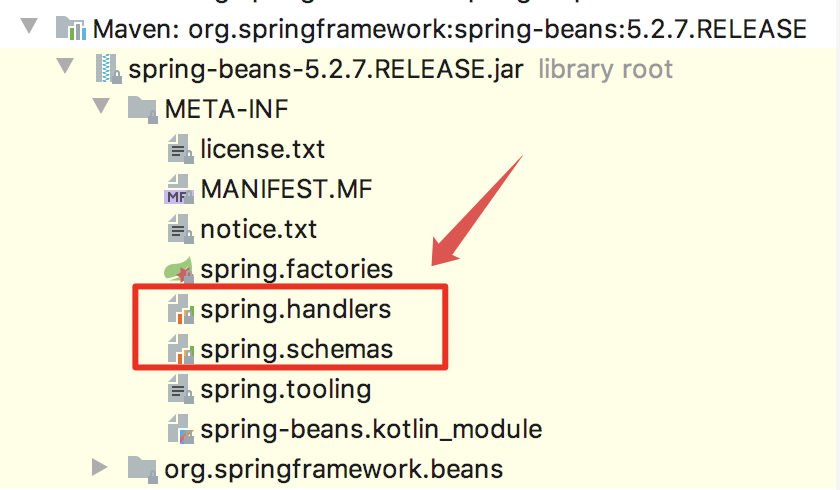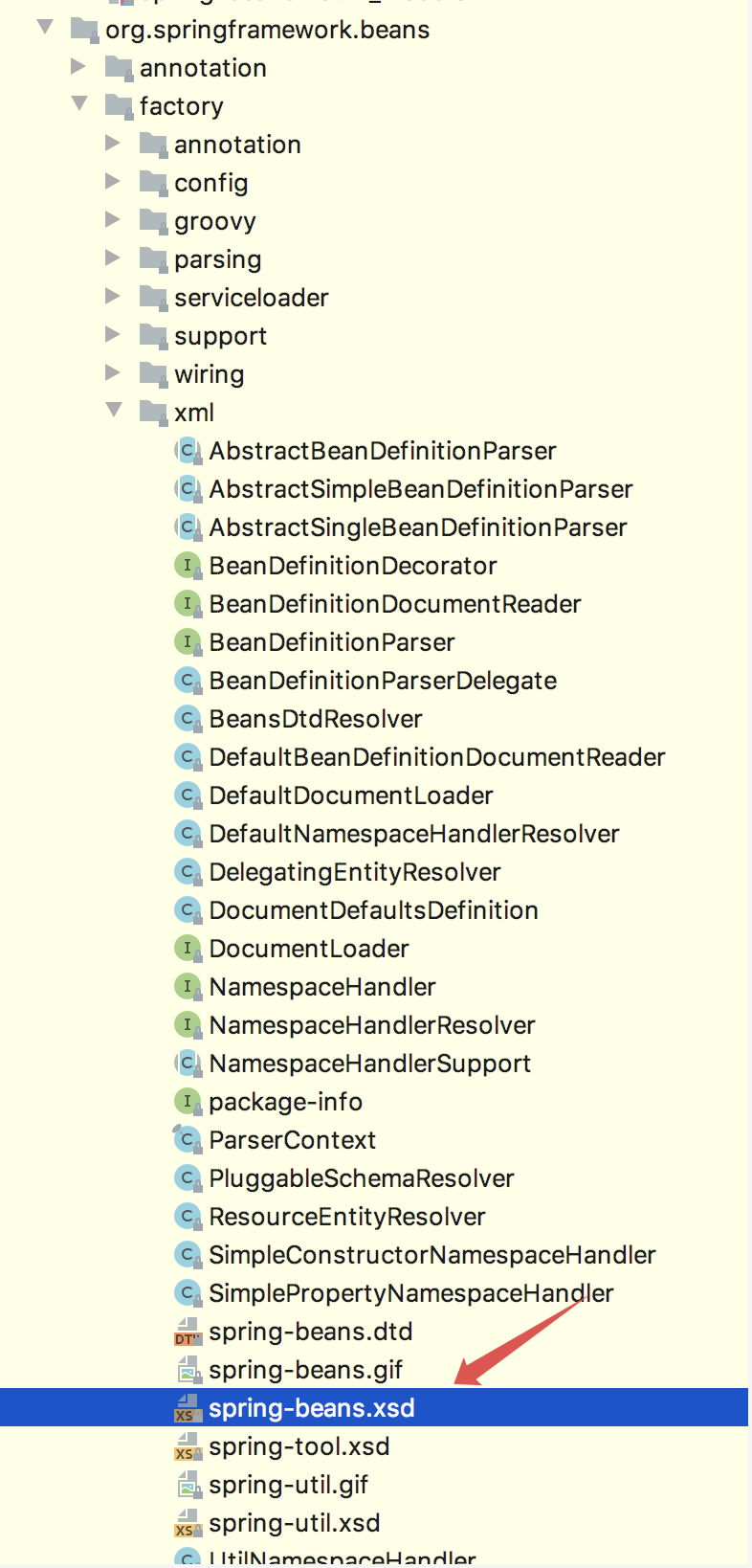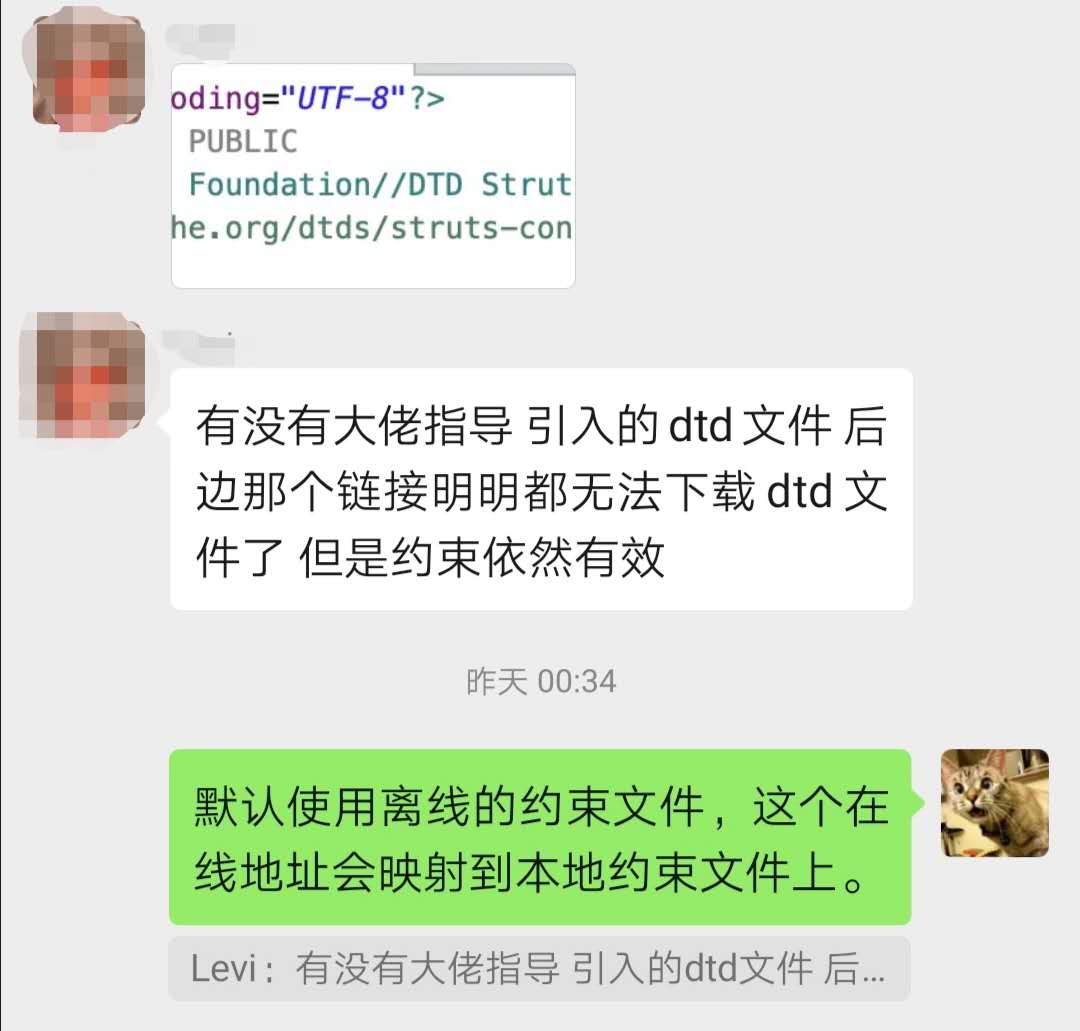上篇文章 和小伙伴们说了 Spring 源码中 XML 文件的解析流程,本来可以继续往下走看加载核心类了,但是松哥还是希望能够慢一点,既然要学就学懂,在 XML 文件解析的过程中还涉及到一些其他的类和概念,因此我就先用几篇文章介绍一下这些涉及到的概念或者类,然后我们再继续往下看。
本文要和大家介绍的是上篇文章 中涉及到的 EntityResolver 类,看看这个类到底是干嘛用的。
本文是 Spring 源码系列第四篇,阅读前面文章有助于更好理解本文:
Spring 源码解读计划 Spring 源码第一篇开整!配置文件是怎么加载的? Spring 源码第二弹!XML 文件解析流程
先来回顾下,在 EntityResolver 这个类在上篇文章 哪里出现了。
我们在讲到 doLoadDocument 方法时,在该方法中调用 loadDocument 方法时,传递的第二个参数就是一个 EntityResolver 实例,当时我们说这个是用来处理文件的验证方式的,但是到底是怎么处理的,今天我们就来看下。
1.XML 验证模式 要了解 EntityResolver,就得先来看看 XML 文件验证模式。
现在我们大多数情况下可能都是使用 JSON 传递数据,XML 使用较少,可能有的小伙伴对 XML 文件的一些规则还不太熟悉,我这里稍微说一下。
XML 是指可扩展标记语言(eXtensible Markup Language),它是一种标记语言,类似 HTML;XML 标签没有被预定义,需要用户自行定义标签,也就是 XML 文件中的节点都是用户自定义的。XML 文件从设计之初就是为了传输数据,而非显示数据。
一般来说,一个 XML 文件由六个部分组成:
文档生命
元素
属性
注释
CDATA 区
处理指令
虽然说 XML 文件本身是没有预定义 XML 标签,但是当 XML 文件作为框架的配置时,对于 XML 标签还是要有一定的约束,否则每个人都按照自己的喜好定义 XML 标签,框架就没法读取这样的 XML 文件了。
在 XML 技术中,开发者可以通过一个文档来约束一个 XML 的文档中的标签,这个文档称之为约束。遵循 XML 语法的 XML 我们称之为格式良好的 XML,而遵循 XML 约束的 XML 我们称之为有效的 XML。XML 约束文档主要定义了在 XML 中允许出现的元素名称、属性及元素出现的顺序等等。
要想约束 XML 标签,有两种方式:
DTD
Schema
DTD(Document Type Definition),全称为文档类型定义,一个 DTD 约束文件我们既可以定义在 XML 文件内部,也可以定义一个本地文件,也可以引用一个网络上的公共的 DTD。
XML Schema 也是一种用于定义和描述 XML 文档结构与内容的模式语言,相比于 DTD,Schema 对于名称空间的支持更加友好,同时也支持更多的数据类型,而且它的约束能力也比较强大,另外还有非常重要的一点是,Schema 文档本身也是 XML 文档,而不是像 DTD 一样使用自成一体的语法。
所以,Schema 目前在 XML 约束这块更具备优势,也在逐渐替代 DTD。
大家在日常开发中,这两种约束可能都见过,但是有的人可能没注意。我给大家简单举一个例子。
早期的 Spring 配置头部是这样的(Spring2.x),这就是 DTD 约束:
1 2 3 4 5 6 <?xml version="1.0" encoding="UTF-8" ?> <!DOCTYPE beans PUBLIC "-//SPRING//DTD BEAN 2.0//EN" "http://www.springframework.org/dtd/spring-beans-2.0.dtd" ><beans > </beans >
现在大家看到的 Spring 配置头部一般都是这样,这就是 Schema 约束:
1 2 3 4 5 6 7 <?xml version="1.0" encoding="UTF-8" ?> <beans xmlns ="http://www.springframework.org/schema/beans" xmlns:xsi ="http://www.w3.org/2001/XMLSchema-instance" xmlns:context ="http://www.springframework.org/schema/context" xsi:schemaLocation ="http://www.springframework.org/schema/beans http://www.springframework.org/schema/beans/spring-beans.xsd http://www.springframework.org/schema/context https://www.springframework.org/schema/context/spring-context.xsd" > </beans >
schema 约束对命名空间有着很好的支持,命名空间可以防止命名冲突,schema 中的名称空间和约束文件都是成对出现的。
有了约束,XML 文件中该写什么不该写什么就固定下来了,这样框架才能成功解析出 XML 文件。
但是大家同时也发现了一个新的问题,无论是 DTD 还是 Schema 约束,给出的约束文件地址都是一个在线地址,这就意味着项目启动时必须能够访问到该在线地址,才能加载到约束文件,如果访问在线约束文件失败,那么项目启动也会失败。
为了解决这个问题,框架一般都是将约束文件放在本地的,在本地哪里呢?实际上就在你下载的 jar 包里。以 spring-beans 为例,在下载的 jar 包里有如下两个文件:
spring.handlers 文件内容如下:
1 2 3 http\://www.springframework.org/schema/c=org.springframework.beans.factory.xml.SimpleConstructorNamespaceHandler http\://www.springframework.org/schema/p=org.springframework.beans.factory.xml.SimplePropertyNamespaceHandler http\://www.springframework.org/schema/util=org.springframework.beans.factory.xml.UtilNamespaceHandler
这其实一个映射配置,每一个名称空间对应的处理类在这里进行配置。
spring.schemas 文件内容如下(部分):
1 2 3 4 5 6 7 8 9 10 http\://www.springframework.org/schema/beans/spring-beans-2.0.xsd=org/springframework/beans/factory/xml/spring-beans.xsd http\://www.springframework.org/schema/beans/spring-beans-2.5.xsd=org/springframework/beans/factory/xml/spring-beans.xsd http\://www.springframework.org/schema/beans/spring-beans-3.0.xsd=org/springframework/beans/factory/xml/spring-beans.xsd http\://www.springframework.org/schema/beans/spring-beans-3.1.xsd=org/springframework/beans/factory/xml/spring-beans.xsd http\://www.springframework.org/schema/beans/spring-beans-3.2.xsd=org/springframework/beans/factory/xml/spring-beans.xsd http\://www.springframework.org/schema/beans/spring-beans-4.0.xsd=org/springframework/beans/factory/xml/spring-beans.xsd http\://www.springframework.org/schema/beans/spring-beans-4.1.xsd=org/springframework/beans/factory/xml/spring-beans.xsd http\://www.springframework.org/schema/beans/spring-beans-4.2.xsd=org/springframework/beans/factory/xml/spring-beans.xsd http\://www.springframework.org/schema/beans/spring-beans-4.3.xsd=org/springframework/beans/factory/xml/spring-beans.xsd http\://www.springframework.org/schema/beans/spring-beans.xsd=org/springframework/beans/factory/xml/spring-beans.xsd
可以看到,各种版本以及没有版本号的约束文件,都对应了同一个文件,就是 org/springframework/beans/factory/xml/spring-beans.xsd,打开这个文件目录,我们就可以看到约束文件:
所以我们虽然在 Spring 的 XML 配置中看到的约束文件是一个在线地址,实际上约束文件是从本地 jar 中读取的。
2.两种解析器 EntityResolver 就是用来处理 XML 验证的。我们先来看下 EntityResolver 接口的定义:
1 2 3 4 5 6 public interface EntityResolver { public abstract InputSource resolveEntity (String publicId, String systemId) throws SAXException, IOException; }
接口中就只有一个方法,就是加载约束文件。在 Spring 中,EntityResolver 的实现类是 DelegatingEntityResolver:
1 2 3 4 5 6 7 8 9 10 11 12 13 14 15 16 17 18 19 20 21 22 23 24 25 26 27 28 29 30 31 32 33 public class DelegatingEntityResolver implements EntityResolver { public static final String DTD_SUFFIX = ".dtd" ; public static final String XSD_SUFFIX = ".xsd" ; private final EntityResolver dtdResolver; private final EntityResolver schemaResolver; public DelegatingEntityResolver (@Nullable ClassLoader classLoader) { this .dtdResolver = new BeansDtdResolver (); this .schemaResolver = new PluggableSchemaResolver (classLoader); } public DelegatingEntityResolver (EntityResolver dtdResolver, EntityResolver schemaResolver) { this .dtdResolver = dtdResolver; this .schemaResolver = schemaResolver; } @Override @Nullable public InputSource resolveEntity (@Nullable String publicId, @Nullable String systemId) throws SAXException, IOException { if (systemId != null ) { if (systemId.endsWith(DTD_SUFFIX)) { return this .dtdResolver.resolveEntity(publicId, systemId); } else if (systemId.endsWith(XSD_SUFFIX)) { return this .schemaResolver.resolveEntity(publicId, systemId); } } return null ; } @Override public String toString () { return "EntityResolver delegating " + XSD_SUFFIX + " to " + this .schemaResolver + " and " + DTD_SUFFIX + " to " + this .dtdResolver; } }
在 DelegatingEntityResolver 类中:
首先通过两种不同的后缀来区分不同的约束。
然后定义了 dtdResolver 和 schemaResolver 两个不同的变量,对应的类型分别是 BeansDtdResolver 和 PluggableSchemaResolver,也就是 dtd 和 schema 的约束验证分别由这两个类来处理。
在 resolveEntity 方法中,根据解析出来不同的后缀,分别交由不同的 EntityResolver 来处理。resolveEntity 解析中有两个参数,如果是 dtd 解析的话,publicId 是有值的,如果是 schema 解析,publicId 为 null,而 systemId 则始终指向具体的约束文件。
由于现在大部分都是 schema 约束,所以这里我们就来重点看下 PluggableSchemaResolver 类的实现:
1 2 3 4 5 6 7 8 9 10 11 12 13 14 15 16 17 18 19 20 21 22 23 24 25 26 27 28 29 30 31 32 33 34 35 36 37 38 39 40 41 42 43 44 45 46 47 48 49 50 51 52 53 54 55 56 57 58 59 60 61 62 63 64 65 66 67 68 69 70 71 72 73 74 75 76 public class PluggableSchemaResolver implements EntityResolver { public static final String DEFAULT_SCHEMA_MAPPINGS_LOCATION = "META-INF/spring.schemas" ; private static final Log logger = LogFactory.getLog(PluggableSchemaResolver.class); @Nullable private final ClassLoader classLoader; private final String schemaMappingsLocation; @Nullable private volatile Map<String, String> schemaMappings; public PluggableSchemaResolver (@Nullable ClassLoader classLoader) { this .classLoader = classLoader; this .schemaMappingsLocation = DEFAULT_SCHEMA_MAPPINGS_LOCATION; } public PluggableSchemaResolver (@Nullable ClassLoader classLoader, String schemaMappingsLocation) { Assert.hasText(schemaMappingsLocation, "'schemaMappingsLocation' must not be empty" ); this .classLoader = classLoader; this .schemaMappingsLocation = schemaMappingsLocation; } @Override @Nullable public InputSource resolveEntity (@Nullable String publicId, @Nullable String systemId) throws IOException { if (logger.isTraceEnabled()) { logger.trace("Trying to resolve XML entity with public id [" + publicId + "] and system id [" + systemId + "]" ); } if (systemId != null ) { String resourceLocation = getSchemaMappings().get(systemId); if (resourceLocation == null && systemId.startsWith("https:" )) { resourceLocation = getSchemaMappings().get("http:" + systemId.substring(6 )); } if (resourceLocation != null ) { Resource resource = new ClassPathResource (resourceLocation, this .classLoader); try { InputSource source = new InputSource (resource.getInputStream()); source.setPublicId(publicId); source.setSystemId(systemId); if (logger.isTraceEnabled()) { logger.trace("Found XML schema [" + systemId + "] in classpath: " + resourceLocation); } return source; } catch (FileNotFoundException ex) { if (logger.isDebugEnabled()) { logger.debug("Could not find XML schema [" + systemId + "]: " + resource, ex); } } } } return null ; } private Map<String, String> getSchemaMappings () { Map<String, String> schemaMappings = this .schemaMappings; if (schemaMappings == null ) { synchronized (this ) { schemaMappings = this .schemaMappings; if (schemaMappings == null ) { try { Properties mappings = PropertiesLoaderUtils.loadAllProperties(this .schemaMappingsLocation, this .classLoader); schemaMappings = new ConcurrentHashMap <>(mappings.size()); CollectionUtils.mergePropertiesIntoMap(mappings, schemaMappings); this .schemaMappings = schemaMappings; } catch (IOException ex) { throw new IllegalStateException ( "Unable to load schema mappings from location [" + this .schemaMappingsLocation + "]" , ex); } } } } return schemaMappings; } @Override public String toString () { return "EntityResolver using schema mappings " + getSchemaMappings(); } }
在这个类中,一上来先通过 DEFAULT_SCHEMA_MAPPINGS_LOCATION 变量定义了 spring.schemas 文件的位置。
getSchemaMappings 方法则是将 spring.schemas 文件中的内容读取成一个 Map 加载进来。
在 resolveEntity 方法中,根据 systemId 找到文件路径,systemId 是 http\://www.springframework.org/schema/beans/spring-beans.xsd 格式,文件路径则是 org/springframework/beans/factory/xml/spring-beans.xsd,如果第一次没有加载到,就把用户的 https: 替换成 http: 再去加载。
有了文件路径,接下来调用 ClassPathResource 去获取一个 Resource 对象,这块可以参考本系列第二篇 ,这里我就不再赘述。
最后构造一个 InputSource 返回即可。
在上篇文章 中,我们获取 EntityResolver 是通过 getEntityResolver 方法来获取的:
1 2 3 4 5 6 7 8 9 10 11 12 13 protected EntityResolver getEntityResolver () { if (this .entityResolver == null ) { ResourceLoader resourceLoader = getResourceLoader(); if (resourceLoader != null ) { this .entityResolver = new ResourceEntityResolver (resourceLoader); } else { this .entityResolver = new DelegatingEntityResolver (getBeanClassLoader()); } } return this .entityResolver; }
这里最终返回的是 ResourceEntityResolver,ResourceEntityResolver 继承自 DelegatingEntityResolver,当调用 resolveEntity 方法时,也是先调用父类的该方法,进行处理,如果父类方法处理成功了,就直接返回父类方法给出的结果,如果父类方法处理失败了,则在 ResourceEntityResolver 中通过资源的相对路径再次尝试加载。
3.小结 好啦,经过上面的介绍,相信大家对于 XMl 约束和 EntityResolver 都有一定的了解啦。
后记
本文刚写完,微信群里就有小伙伴问了一个一模一样的问题:
松哥不禁感叹,源码并非离我们很远的东西,阅读源码可以有效解决我们日常开发中一些实实在在的问题!
如果觉得有收获,记得点个在看鼓励下松哥哦~



